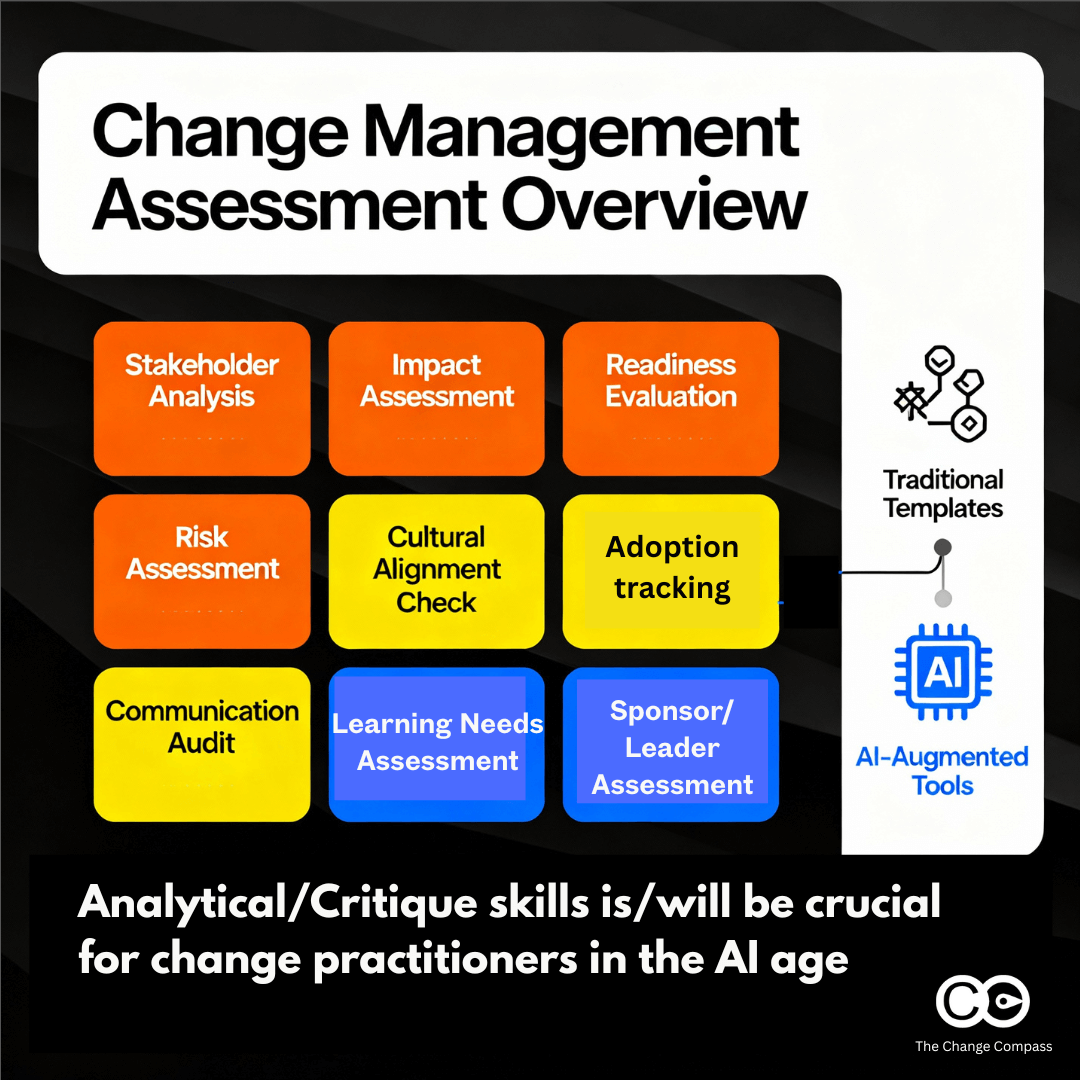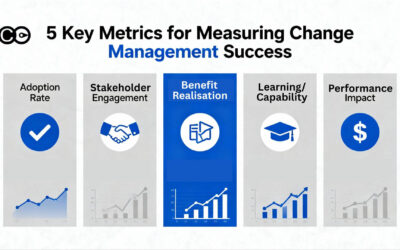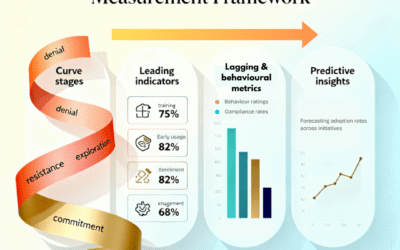Change management assessments are the foundation of successful transformation. Yet many change practitioners treat them like compliance boxes to tick rather than strategic tools that reveal the real story of whether change will stick. The difference between a thorough assessment and a surface-level one often determines whether a transformation delivers business impact or becomes another expensive learning experience.
The evolution of change management assessments reflects a shift in how mature organisations approach transformation. Beginners follow methodologies, use templates, and gather information in structured ways. That’s valuable starting ground. But experienced practitioners do something different. They look for patterns in the data, drill into unexpected findings, challenge surface-level conclusions, and adjust their approach continuously as new insights emerge. Most critically, they understand that assessments without data are just opinions, and opinions are rarely reliable guides for multi-million pound transformation decisions.
The future of change management assessments lies in combining digital and AI tools that can rapidly identify patterns and connections across massive datasets with human interpretation and contextual insight. Technology handles the heavy lifting of data collection and pattern recognition. Change practitioners apply experience, intuition, and business understanding to translate findings into meaningful strategy.
Understanding the Scope of Change Management Assessments
Change management assessments come in many forms, each serving a distinct purpose in the transformation lifecycle. Most practitioners use multiple assessment types across a single transformation initiative, layering insights to build a comprehensive picture of readiness, impact, risk, and opportunity.
The most common mistake organisations make is using a single assessment type and believing it tells the whole story. It doesn’t. A readiness assessment reveals whether people feel ready but doesn’t tell you what skills they actually need. A cultural assessment identifies organisational values but doesn’t map who will resist. A stakeholder analysis shows whom matters in the change but doesn’t reveal their specific concerns. A learning needs assessment identifies training gaps but doesn’t connect to adoption barriers. Only by using multiple assessment types, layering insights, and looking for connections between findings can you understand the true landscape of your transformation.
Core Types of Change Management Assessments
Impact Assessment: Understanding What’s Really Changing
Impact assessment is the starting point for any transformation. It answers a fundamental question: what will actually change, and who does it affect?
An impact assessment goes beyond the surface-level project scope statement. It identifies every function, process, system, role, and team affected by the transformation. More importantly, it measures the magnitude of impact: is this a minor tweak to how people work, or a fundamental reshaping of processes and behaviours?
Impact assessment typically examines:
- Process changes (what activities will be different)
- System changes (what technology or tools will change)
- Organisational changes (what reporting lines, structures, or roles will shift)
- Role changes (what responsibilities each person will have)
- Skill requirement changes (what new competencies are needed)
- Culture changes (what new behaviours or mindsets are required)
- Operational changes (what performance metrics will shift)
The data collected during impact assessment shapes everything downstream. Without clarity on impact, you can’t accurately scope training needs, can’t properly segment stakeholders, and can’t build a realistic change management budget. Many transformation programmes discover halfway through that they fundamentally misunderstood the scope of impact, forcing painful scope changes or inadequate mitigation strategies.
Experienced change practitioners know that impact assessment isn’t just about listing what’s changing. It’s about understanding the ripple effects. When you implement a new system, yes, people need training on the system. But what other impacts cascade? If the system changes workflow sequencing, other teams need to understand how their dependencies shift. If it changes approval permissions, people need clarity on who now has decision rights. If it changes performance metrics, people need to understand new success criteria. Impact assessment identifies these cascading effects before they become surprises during implementation.
Sample impact assessment
| Function/Department | Number of Staff | Impact Level | Process Changes | System Changes | Skill Requirements | Behaviour Shifts |
|---|---|---|---|---|---|---|
| Loan Operations | 95 | HIGH | 85% of workflow affected | Complete system replacement | 12 new technical competencies | Shift from approval-based to data-driven decision-making |
| Credit Risk | 32 | MEDIUM | Risk approval steps remain but timing shifts | Integration with new system | 5 new risk analysis capabilities | More rapid decision cycles required |
| Customer Service | 120 | LOW | Customer-facing interface improves but core responsibilities unchanged | New CRM interface | 3 new system features | Proactive customer communication approach |
| Finance & Reporting | 15 | MEDIUM | New metrics and reporting required | New reporting module | 4 new reporting skills | Real-time reporting vs monthly cycles |
| Compliance | 8 | MEDIUM | New compliance verification steps | Audit trail enhancements | 2 new compliance processes | Continuous monitoring vs spot-checks |
| IT Support | 12 | HIGH | Support model fundamentally changes | New ticketing system | 8 new technical support skills | Shift from reactive to proactive support |
Cultural Assessment: Evaluating Organisational Readiness for Change
Culture is rarely measured but constantly influences transformation outcomes. Cultural assessment evaluates the values, beliefs, assumptions, and unwritten rules within an organisation that shape how people respond to change.
Cultural dimensions that affect change outcomes include:
- Risk orientation: Is the culture risk-averse or entrepreneurial? This determines whether people embrace or resist change.
- Trust in leadership: Do employees believe leadership has good intentions and sound judgement? This affects whether people follow leadership guidance.
- Pace of decision-making: Is the culture deliberate and careful, or fast-moving and adaptable? This shapes whether transformation timelines feel realistic or rushed.
- Accountability clarity: Are people comfortable with clear accountability, or do they prefer ambiguity? This affects whether new role clarity feels empowering or controlling.
- Learning orientation: Does the culture embrace experimentation and learning from failure, or does it punish mistakes? This influences whether people adopt new approaches.
- Collaboration norms: Do people naturally work across silos, or are functions protective? This shapes whether cross-functional change governance feels natural or forced.
Cultural assessment typically uses surveys, interviews, and focus groups to gather employee perspectives on these dimensions. The goal is to identify cultural strengths that will support change and cultural obstacles that will create resistance.
The insight here is often counterintuitive. A strong, unified culture can actually impede change if the culture is change-resistant. A culture that prides itself on “how we do things here” will push back against “doing things differently.” Conversely, organisations with more fluid, adaptive cultures often experience faster adoption. Experienced practitioners don’t judge culture as good or bad; they assess it realistically and build mitigation strategies that work with cultural reality rather than fighting it.
Stakeholder Analysis: Mapping Influence, Interest, and Engagement
Stakeholder analysis identifies everyone affected by transformation and categorises them by influence and interest. This determines engagement strategy: who needs constant sponsorship? Who needs information? Who will naturally resist? Who are likely advocates?
Stakeholder analysis typically uses a matrix that plots stakeholders by influence (high/low) and interest (high/low), creating four quadrants:
- High influence, high interest: Manage closely. These are your key players.
- High influence, low interest: Keep satisfied. They can block progress if dissatisfied.
- Low influence, high interest: Keep informed. They’re advocates but not decision-makers.
- Low influence, low interest: Monitor. They’re not critical to success but shouldn’t be ignored.
Beyond the matrix, sophisticated stakeholder analysis profiles individual stakeholder motivations: what does each person care about? What are their concerns? What will they gain or lose? What language and communication approach resonates with them?
The transformation benefit emerges when you layer stakeholder analysis with other insights. When you combine stakeholder influence mapping with cultural assessment, you can predict where resistance will come from and who has power to either amplify or neutralise that resistance. When you combine stakeholder analysis with learning needs assessment, you understand what support each stakeholder group requires. The patterns that emerge from multiple data sources are far richer than any single assessment.
Readiness Assessment: Evaluating Preparation for Change
Change readiness assessment comes in two flavours, and experienced practitioners use both.
Organisational readiness assessment happens before the project formally starts. It evaluates whether the organisation has the structural and cultural foundation to support transformation: Do we have a committed sponsor? Do we have change infrastructure and governance? Do we have resources allocated? Do we have clarity on what we’re trying to achieve? Is leadership aligned? This assessment answers the question: should we even attempt this transformation right now, or should we address foundational issues first?
Adoption readiness assessment happens just before go-live. It evaluates whether people are actually prepared to adopt the change: Have they completed training? Do they understand how their role will change? Is their manager prepared to support them? Are support structures in place? Do they feel confident in their ability to succeed? This assessment answers the question: are we ready to launch, or do we need final preparation?
Readiness assessment typically examines seven dimensions:
- Awareness: Do people understand what’s changing and why?
- Desire: Do people believe the change is necessary and beneficial?
- Knowledge: Do people have the information and skills needed?
- Ability: Do people have systems, processes, and infrastructure to execute?
- Support: Is leadership visibly committed and actively removing barriers?
- Culture and communication: Is there trust, openness, and honest dialogue?
- Commitment: Will people sustain the change long-term?
The data reveals what readiness actually exists versus what’s assumed. Many organisations assume that if people attended training, they’re ready. Assessment data often shows something different: training completion and actual readiness are correlates, not equivalents. People can attend training and remain unconfident or unconvinced. Assessment finds these gaps before they become adoption failures.
Readiness assessment sample output
Assessment Type: Organisational Readiness (Pre-Transformation)
Initiative: Customer Data Platform Implementation
Readiness Scorecard:
| Dimension | Score | Status | Comment |
|---|---|---|---|
| Sponsorship Commitment | 8/10 | Strong | CEO personally championing; allocated budget |
| Leadership Alignment | 6/10 | Caution | Finance and Ops aligned; Technology concerns about timeline |
| Change Infrastructure | 5/10 | At Risk | No dedicated change function; relying on project team |
| Resource Availability | 7/10 | Good | Core team allocated; limited surge capacity |
| Clarity of Vision | 8/10 | Strong | Compelling business case; clear success metrics |
| Cultural Readiness | 5/10 | At Risk | Risk-averse organisation; past project failures causing hesitation |
| Stakeholder Buy-In | 6/10 | Caution | Early adopters engaged; middle management unconvinced |
Learning Needs Assessment: Identifying Capability Gaps
Learning needs assessment identifies what knowledge and skills people need to perform effectively in the new state and what gaps exist today.
A complete learning needs assessment examines:
- Knowledge gaps: What do people need to know about new systems, processes, and ways of working?
- Skill gaps: What new capabilities are required?
- Behaviour gaps: What new ways of working must people adopt?
- Confidence gaps: Where do people feel unprepared or uncertain?
- Role-specific needs: What are differentiated needs by role, function, or seniority?
The insight emerges when you look for patterns. Which teams have the largest gaps? Which roles feel most uncertain? Are gaps concentrated in specific functions or spread across the organisation? Do gaps cluster around particular topics or specific systems? These patterns shape training strategy, timing, and emphasis.
Experienced practitioners know that learning needs assessment connects to adoption barriers. If specific groups have large capability gaps, they’ll likely struggle with adoption. If specific topics generate high uncertainty, they’ll need more support. If certain roles feel unprepared, they’ll become adoption blockers. By identifying these connections early, practitioners can build targeted interventions.
Adoption Assessment: Measuring Actual Behavioural Change
Adoption assessment is perhaps the most critical yet often most neglected assessment type. It measures whether people are actually using new systems, processes, and ways of working correctly and consistently.
Adoption assessment goes beyond tracking login frequency or training completion. It examines:
- System usage: Are people using the system? Which features are used, and which are ignored?
- Workflow adherence: Are people following new processes, or reverting to old ways?
- Proficiency progression: Are people becoming more skilled over time, or plateauing?
- Workarounds: Where are people working around new systems or processes?
- Behavioural change: Are new, desired behaviours becoming embedded?
- Compliance: Are people following required controls and governance?
The patterns that emerge reveal what’s actually working and what isn’t. High adoption in some areas but resistance in others suggests the change fits some business contexts but conflicts with others. Rapid adoption followed by plateau suggests initial enthusiasm but difficulty sustaining change. Widespread workarounds suggest the new system or process has design gaps or conflicts with real operational needs.
Adoption assessment is where data and human interpretation diverge most sharply. The data shows what’s happening. The interpretation determines why. Is low adoption a change management failure (people don’t understand or don’t want the change), an adoption support failure (they want to change but lack resources or capability), a design failure (the new system or process doesn’t actually work for their context), or a business case failure (the change doesn’t deliver the promised benefits)? Each root cause requires different mitigation. Data alone can’t tell you the answer; experience and contextual understanding can.
Behavioural Change Tracking:
| Behaviour | Adoption Rate | Trend |
|---|---|---|
| Submitting expenses via system | 72% | Increasing |
| Using digital receipts instead of paper | 48% | Increasing but slow |
| Submitting on time (vs overdue) | 61% | Slight decline |
| Approving expenses in system | 85% | Strong |
Compliance and Risk Assessment: Understanding Regulatory and Operational Risk
Compliance and risk assessment evaluates whether transformation activities maintain regulatory compliance, control adherence, and operational risk management.
This assessment typically examines:
- Control effectiveness: Are required controls still operating correctly during and after transition?
- Regulatory compliance: Are we maintaining compliance with relevant regulations during change?
- Data security: Are we protecting sensitive data throughout transition?
- Process integrity: Are critical processes maintained even as we change other elements?
- Operational risk: What new risks are introduced by the transformation?
The insight here is often stark: many transformations discover during implementation that they’re creating compliance or control gaps. System transitions may leave periods where controls are weaker. New processes may have unintended compliance implications. Data migration may create security exposure. Early risk assessment identifies these issues before they become problems, allowing mitigation planning.
Compliance and risk assessment sample output
Assessment: Control Environment During System Transition
Initiative: Manufacturing ERP Implementation
Critical Control Status During Transition:
| Control | Pre-Migration Status | Migration Risk | Post-Migration Status | Mitigation |
|---|---|---|---|---|
| Segregation of Duties (Purchasing) | Operating | HIGH | Design verified | Dual sign-off during transition |
| Inventory Cycle Counts | Operating | MEDIUM | Design verified | Weekly counts during transition period |
| Financial Reconciliation | Operating | HIGH | Design verified | Parallel run for 30 days |
| Approval Authorities | Operating | MEDIUM | Reconfigured | Training on new authority matrix |
| Audit Trail | Not available | MEDIUM | Enhanced | Data retention policy reviewed |
The Role of Analysis and Analytical Skills
Here’s where experienced change practitioners distinguish themselves from those following templates: the ability to analyse assessment data, find patterns, and translate findings into strategic insight.
Template-based approaches gather assessment data, check boxes, and move to predetermined next steps. Analytical approaches ask harder questions of the data:
- What patterns emerge across multiple assessments? If readiness assessment shows low awareness but high desire, that’s different from low desire and high awareness. The first needs communication; the second needs benefits clarity.
- Where do assessments conflict or create tension? If cultural assessment shows a risk-averse culture but impact assessment shows the change requires risk-embracing behaviours, that’s a critical tension requiring specific mitigation strategy.
- Which findings are unexpected? Unexpected patterns often reveal important insights that predetermined templates miss.
- What do the findings suggest about root causes versus symptoms? Surface-level resistance might stem from awareness gaps, capability gaps, cultural misalignment, or stakeholder concerns. Each has different solutions.
- How do findings in one area cascade to other areas? Low adoption readiness in one function might cascade to adoption failures in dependent functions.
Analytical skills require comfort with ambiguity. Assessment data rarely tells a clear story. More commonly, it tells multiple stories that require interpretation. Experienced practitioners synthesise across data sources, form hypotheses about what’s really happening, and design targeted interventions to test and refine those hypotheses.
The Evolution: From Templates to Technology to Intelligence
Change management practice is evolving through distinct phases.
Phase 1: Template-based assessment dominated for years. Standard questionnaires, predetermined analysis, checkbox completion. Templates provided structure and consistency, which was valuable for bringing consistency to change management practice. The limitation: templates assume one size fits all and rarely surface unexpected insights.
Phase 2: Data-driven assessment emerged as practitioners recognised that larger data sets reveal patterns templates miss. Instead of a standard questionnaire, assessment included multiple data sources: surveys, interviews, focus groups, historical project data, performance metrics, employee sentiment analysis. The limitation: even with more data, human capacity to synthesise complex information across multiple sources is limited.
Phase 3: Digital/AI-augmented assessment is emerging now. Digital platforms collect assessment data at scale and speed impossible for humans. Machine learning identifies patterns across thousands of data points and surfaces anomalies and correlations humans might miss. But here’s the critical insight: AI may not always be reliable at interpretation across different types of data forms. It can tell you that adoption is lower in division X than division Y. It might not always be accurate in telling you whether that’s because division X has a change-resistant culture, because the change conflicts with their business model, because their local leadership isn’t visibly committed, or because their systems don’t integrate well with the new platform. The various layers of nuances plus data interpretation requires human judgment, critique, business context, and change experience.
The future of change management assessment lies in this combination: AI handling data collection, pattern recognition, and anomaly detection at scale, supplemented by human interpretation that understands context, causation, and strategy.
How to Build Assessment Rigour Into Your Approach
Regardless of the assessment types you use, several principles improve quality and insight:
Use multiple data sources. Single-source data is unreliable. Surveys show what people think; interviews show what they really believe; project history shows what actually happens. Layering sources reduces individual bias.
Segment your data. Aggregate data hides important variation. Breaking data by function, location, seniority level, or job role often reveals where challenges concentrate and where strengths lie.
Look for patterns and contradictions. Where multiple assessments show consistent findings, you’ve found solid ground. Where assessments contradict, you’ve found important tensions requiring investigation.
Question unexpected findings. When assessment data contradicts assumptions or conventional wisdom, dig deeper before dismissing the finding. Often these are the most important insights.
Connect findings to strategy. Assessment findings should shape change management strategy. If readiness assessment shows low awareness, communication strategy must shift. If cultural assessment shows misalignment with required behaviours, you need specific culture change work. If stakeholder analysis shows concentrated resistance, you need targeted engagement strategy.
Reassess throughout the transformation. Assessment isn’t a one-time event. Conditions change as you move through transformation phases. Early assessment findings may no longer apply by mid-programme. Reassessment at key milestones tracks whether your mitigation strategies are working.
Making Assessment Practical
The risk with comprehensive assessment guidance is it sounds overwhelming. Here’s how to make it practical:
Start with the assessments most critical to your specific transformation. You don’t need all assessment types for every change. Match assessment type to your biggest uncertainties or risks.
Use assessment to test specific hypotheses. Rather than generic “what’s your readiness?” ask “do you understand how your role will change?” This makes assessment data actionable.
Combine template efficiency with analytical depth. Use standard survey templates for consistency and comparable data. Then drill into unexpected patterns with targeted interviews and focus groups.
Invest in interpretation time. The assessment data collection is the easy part. The valuable work is stepping back and asking “what does this really mean for my transformation strategy?”
The Future of Assessment: Data Plus Insight
Change management assessments are at an inflection point. The frameworks and methods have matured. What’s evolving is the way we gather, analyse, and interpret assessment data.
Technology enables assessment at unprecedented scale and speed. Organisations can now assess thousands of employees, track sentiment evolution through transformation phases, and correlate adoption patterns with dozens of organisational variables. The pace of data collection and pattern recognition is transforming.
What hasn’t changed and won’t change is the need for human expertise to interpret and critique findings, understand context, and translate data into strategy. An AI might identify that adoption is declining in specific roles or locations. A change practitioner interprets whether that’s a training issue, a support issue, a design issue, or a business case issue, and designs appropriate response.
The organisations that will excel at transformation are those that combine both: technology that amplifies human capability by handling data collection and pattern recognition, and experienced practitioners who interpret findings and design strategy based on understanding of organisation, context, and change leadership.
Key Takeaways
Change management assessments are not compliance exercises. They’re strategic tools for understanding whether transformation will succeed or fail. Using multiple assessment types, looking for patterns across assessments, and combining analytical skill with technology creates the foundation for transformation success. The organisations that treat assessment as rigorous analysis rather than checkbox completion consistently achieve better transformation outcomes.
Frequently Asked Questions: Change Management Assessments
What is the difference between readiness assessment and adoption assessment?
Organisational readiness assessment happens before transformation begins and evaluates whether the organisation is structurally and culturally prepared to undertake change. It asks: do we have committed sponsorship, resources, aligned leadership, and infrastructure? Adoption readiness assessment happens just before go-live and evaluates whether employees are prepared to actually adopt the change. It asks: have people completed training, do they understand how their role changes, are support structures in place? Both are essential; they serve different purposes at different transformation phases. On the other hand, actual adoption tracking and monitoring happens after the project release.
Why do many transformations fail despite passing readiness assessments?
Readiness assessments measure perceived readiness and infrastructure readiness, not actual capability or genuine commitment. People can report feeling ready on a survey but lack actual skills, still hold reservations or just become busy with other work focus priorities. Leadership can appear committed in formal settings but subtly undermine change through conflicting priorities. Organisations can have assessment processes in place but lack follow-through on issues the assessment revealed. True success requires not just assessment but acting on assessment findings throughout transformation.
How do I connect assessment findings to actual change management strategy?
Assessment findings should directly shape strategy. If readiness assessment shows awareness gaps, communication intensity must increase. If cultural assessment shows risk-averse culture but change requires risk-embracing behaviours, you need explicit culture change work alongside training. If stakeholder analysis shows concentrated resistance among key influencers, targeted engagement strategy is essential. If adoption assessment shows workarounds, the system or process design may need refinement. Each finding type should trigger specific, tailored strategy responses.
What’s the most critical assessment type for transformation success?
Adoption assessment is perhaps most critical because it measures what actually matters: whether people are using new ways of working correctly. Results may be used to reinforce or support adoption. However, no single assessment type tells the complete story. For example, readiness assessment is critical because it is the predictor for adoption. On top of this, having an accurate impact assessment is key as it forms the overall change approach. Comprehensive transformation success requires multiple assessment types at different phases, layering insights to understand readiness, impact, capability, risk, and actual outcomes. The assessment types work together to build approach strategic clarity.






